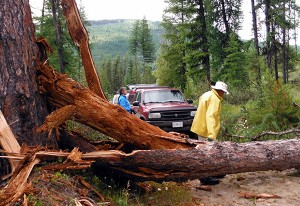Home »

Adventure and enlightenment with the Rocky Mountain Naturalists
“Naturalists aren’t pansies, you know.”
I can’t remember who made the remark, but it definitely caught my attention as I rode down a bumpy logging road southeast of Moyie in a four-by-four packed with several members of the Rocky Mountain Naturalist Club the day after the big wind storm last week.
It wasn’t long before I found out that naturalists do more than count birds, name flowers and record almost everything they see from insects to grizzly bears. They’re also pretty handy with a chainsaw, which just what our three-vehicle group needed the day after the storm that tore a swath through the forest we were driving through on our way to the Gilnockie Creek Ecological Reserve in the wilds between Moyie and Baynes Lake.
It’s a long drive into Gilnockie from the north, more than 50 km of hard-pan and gravel, and it didn’t help to be driving through a largely lodgepole pine forest that had already been heavily logged and opened to a wind that roared in from the southwest in a storm packing buckets of rain and microbursts of wind that snapped some trees several feet up their trunks or tore them out of the ground and across the twisty road.
Ironically, it was trees that we we’re going to see because the Gilnockie Reserve was established in 1981 to conserve and protect a wilderness stand of giant Larix Occidentalis or Golden Western Larch as it’s commonly known with some approaching 500 years of age and soaring close to 150 feet in the sky. Although not a true naturalist myself, I eagerly joined this trip because larch, or “tamarack” as they are sometimes mistakenly called in this area, are a personal favorite of mine with their soft clusters of needles that turn to gold every autumn and their thick, pinkish bark that protect them from fires and give them, along with their great height, the appearance of northern Redwoods. Or that’s what I like to think.
 Thanks to Gilnockie Creek Ecological Reserve Warden Anni Coulter, who had the presence of mind to toss a small chainsaw into her vehicle, so we weren’t forced to be turned back by more than a dozen windfalls across the road, including a large, gnarly, larch tree, rotten with old age, that fell like a leviathan out of the sky and for all intents and purposes ended our trip that day. But naturalists aren’t pansies, you know, and it wasn’t long before the little chainsaw that tried harder cut its way through the spongy, old wood of the ancient larch and a chain was wrapped around it and hooked to one of our four-by-fours and dragged to the side of the road.
Thanks to Gilnockie Creek Ecological Reserve Warden Anni Coulter, who had the presence of mind to toss a small chainsaw into her vehicle, so we weren’t forced to be turned back by more than a dozen windfalls across the road, including a large, gnarly, larch tree, rotten with old age, that fell like a leviathan out of the sky and for all intents and purposes ended our trip that day. But naturalists aren’t pansies, you know, and it wasn’t long before the little chainsaw that tried harder cut its way through the spongy, old wood of the ancient larch and a chain was wrapped around it and hooked to one of our four-by-fours and dragged to the side of the road.
Mission accomplished; but then a touching sight. The old larch was a “wildlife tree” riddled with holes eaten out by various ants and bugs and home to several bird nests that came crashing to the ground with it. There was a wing here and a leg there, but one young nestling about to fledge lay chirping shrilly on the road beside the downed tree and very much still alive, though injured by, what for it, must have been an earth-shaking fall. And here, with Anni leading the way, the naturalists showed their true mettle.

The injured bird, a Northern Flicker, was gathered up and taken several feet up the hillside away from the road and a makeshift nest was made for him of moss, bark and dirt and he was packed into it and fed some tasty grubs, which he eagerly gobbled down – hopefully not a Last Supper – and left in hopes that his mother would return and save at least one of her nestlings. A faint hope, maybe, but a hope just the same. Just because naturalists aren’t pansies doesn’t mean they don’t have a heart, you know.
Well, I’d like to tell you more about the rest of the day, but I don’t have room here. We eventually made it to the Gilnockie Reserve and Anni led us all around it as we slogged through wet swamp grass, rocky hillsides and over slippery logs and gawked in awe at the giant larch monarchs of what seemed a Tolkein-like forest. Thank God for ecological reserves! There must be close to 500 of them in B.C. And they exist to conserve and protect rare and unique species all over the province and not for the exploitation of tourists and recreationalists that would cause them great harm by their sheer numbers and mechanized forms of travel.
And if you want to find out more about the Rocky Mountain Naturalists check out their website at: https://www.rockymountainnaturalists.org/
They aren’t pansies, you know.
– Gerry Warner is a retired journalist and a Cranbrook City Councillor. He likes pansies and his opinions are his own.








